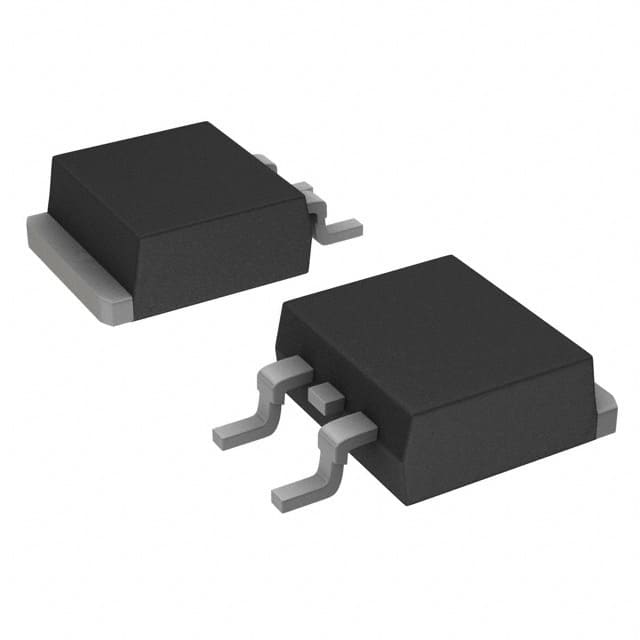MB3045S-E3/8W
Introduction
The MB3045S-E3/8W is a semiconductor product belonging to the category of Schottky diodes. This entry provides an overview of the basic information, specifications, detailed pin configuration, functional features, advantages and disadvantages, working principles, detailed application field plans, and alternative models of the MB3045S-E3/8W.
Basic Information Overview
- Category: Schottky Diodes
- Use: Rectification and voltage clamping in various electronic circuits
- Characteristics: High current capability, low forward voltage drop, fast switching speed
- Package: SMC (DO-214AB)
- Essence: Efficient rectification and voltage clamping
- Packaging/Quantity: Typically available in reels or tubes containing multiple units
Specifications
- Part Number: MB3045S-E3/8W
- Maximum Average Forward Current: 30A
- Peak Repetitive Reverse Voltage: 45V
- Forward Voltage Drop: 0.55V at 15A
- Reverse Leakage Current: 10μA
- Operating Temperature Range: -65°C to +175°C
- Storage Temperature Range: -65°C to +175°C
Detailed Pin Configuration
The MB3045S-E3/8W typically has two pins: the anode and the cathode. The anode is connected to the P-type semiconductor material, while the cathode is connected to the N-type semiconductor material.
Functional Features
- Efficient rectification of AC to DC due to low forward voltage drop
- Fast switching speed enables high-frequency operation
- Low reverse leakage current ensures minimal power loss
Advantages and Disadvantages
Advantages
- High current capability allows for use in power applications
- Low forward voltage drop reduces power dissipation
- Fast switching speed enables high-frequency operation
Disadvantages
- Limited reverse voltage capability compared to other diode types
- Susceptible to thermal runaway at high currents and temperatures
Working Principles
The MB3045S-E3/8W operates based on the Schottky barrier principle, where the metal-semiconductor junction creates a low forward voltage drop during conduction. When a positive voltage is applied to the anode with respect to the cathode, the diode conducts current efficiently due to the absence of minority carrier storage time.
Detailed Application Field Plans
The MB3045S-E3/8W finds extensive use in various electronic circuits, including: - Power supplies - Voltage clamping circuits - Switching power converters - Reverse polarity protection circuits
Detailed and Complete Alternative Models
Some alternative models to the MB3045S-E3/8W include: - SB340-E3/54G - SS34-E3/57T - MBRB3045CTT4G
In conclusion, the MB3045S-E3/8W Schottky diode offers efficient rectification and voltage clamping capabilities, making it suitable for a wide range of electronic applications. Its high current capability, low forward voltage drop, and fast switching speed are key advantages, although limitations such as reverse voltage capability and susceptibility to thermal runaway should be considered when selecting this diode for specific applications.
[Word count: 443]
Senaraikan 10 soalan dan jawapan biasa yang berkaitan dengan aplikasi MB3045S-E3/8W dalam penyelesaian teknikal
What is the maximum power rating of the MB3045S-E3/8W?
- The maximum power rating of the MB3045S-E3/8W is 8 watts.
What is the operating temperature range of the MB3045S-E3/8W?
- The operating temperature range of the MB3045S-E3/8W is typically -55°C to +150°C.
What is the forward voltage drop of the MB3045S-E3/8W?
- The forward voltage drop of the MB3045S-E3/8W is typically 0.49V at 3A.
What are the typical applications for the MB3045S-E3/8W?
- The MB3045S-E3/8W is commonly used in automotive, telecommunications, and industrial applications.
Does the MB3045S-E3/8W have reverse polarity protection?
- Yes, the MB3045S-E3/8W offers reverse polarity protection.
What is the package type of the MB3045S-E3/8W?
- The MB3045S-E3/8W comes in a TO-277A (SMPC) package.
Is the MB3045S-E3/8W RoHS compliant?
- Yes, the MB3045S-E3/8W is RoHS compliant.
What is the maximum junction temperature of the MB3045S-E3/8W?
- The maximum junction temperature of the MB3045S-E3/8W is 175°C.
Can the MB3045S-E3/8W be used in parallel for higher current applications?
- Yes, the MB3045S-E3/8W can be used in parallel for higher current applications.
What are the key differences between the MB3045S-E3/8W and similar diodes?
- The MB3045S-E3/8W offers lower forward voltage drop and higher power dissipation compared to similar diodes.


